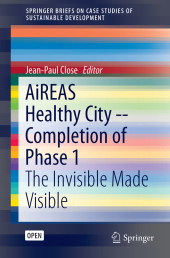 Neuerscheinungen 2016Stand: 2020-02-01 |
Schnellsuche
ISBN/Stichwort/Autor
|
Herderstraße 10
10625 Berlin
Tel.: 030 315 714 16
Fax 030 315 714 14
info@buchspektrum.de |

Jean-Paul Close
AiREAS: Sustainocracy for a Healthy City
The Invisible made Visible Phase 1
Herausgegeben von Close, Jean-Paul
1st ed. 2016. 2016. xiii, 113 S. 47 Farbabb. 235 mm
Verlag/Jahr: SPRINGER, BERLIN; SPRINGER INTERNATIONAL PUBLISHING 2016
ISBN: 3-319-26939-9 (3319269399)
Neue ISBN: 978-3-319-26939-9 (9783319269399)
Preis und Lieferzeit: Bitte klicken
This
book describes the coming about and first results of the AiREAS "healthy
city" cooperative in the city of Eindhoven and Province of North Brabant
in the Netherlands. AiREAS is an initiative focused on the multidisciplinary
co-creation of healthy cities using the core human value of human health and
air quality as guiding principle for profound regional innovation. The unique
group process that followed uses the complexity of the city of Eindhoven as
living lab. It is an anthropology based initiative that invites directly to the
same table of core innovative responsibility the local government, innovative
business partners, scientific insights and research, and civilian participation.
The first phase is described here in which the consortium decided to want to
make the invisible of air pollution and human exposure visible for the integral
innovative participation of all city´s core pillars (policy, education,
infrastructure, culture and entrepreneurship). The experience is unique in the
world and proceeding now with more phases in Eindhoven and the role out of the
same working format in other cities. This Brief is made available to inspire
the world to address together the most complex issues of our current era:
pollution, climate and core human values.
Introduction.- Part I Potted Review of Economic Theory: The
Complex Evolving System.- 1. A Potted Review.- Part II Early Days: From
Personal Awareness to Group Commitment.- 2. A personal story of awareness and
perception.- 2.1 My first awareness breakthrough.- 2.2 Layers of awareness.- 2.3
My second burst of awareness.- 2.4 Defining a new society for myself.- 2.5 Key
human values.- 2.6 Inside = outside.- 2.7 To be and to do.- 2.7 Welfare or wellbeing?.- 2.8 Business
transformation.- 2.9 Leadership versus management.- 2.10 STIR Foundation - City
of Tomorrow.- 2.11 Sustainocracy.- 2.12 City of Tomorrow.- 2.13 The Amsterdam
internet congress.- 2.14 Key elements that define "sustainocratic" AiREAS.- 2.15
AiREAS.- 2.16 Commitment first.- 2.17 Territorial focus.- 2.18 Local AiREAS
Eindhoven.- 2.19 First things first.- 2.20 Making visible the invisible.- 2.21
From idea to project.- 2.22 Conclusion about the coming about of AiREAS.- 2.23
Link with ethics and economies.- Part III "The Invisible made Visible": science
and technology.- An introduction by Marco van Lochem.- 3.1 The ILM.- 3.2.
Variables measured.- 3.3.3. Instrumentation.- 3.3.1 The Airbox.- 3.3.2 PM
(PM10, PM2.5, PM1) sensor.- 3.3.3 UFP sensor.- 3.3.4 Ozone sensor.- 3.3.5 NO2
sensor.- 3.3.6 Temperature sensor and relative humidity sensor.- 3.3.7
Electromagnetic compatibility (EMC).- 3.3.8 Experiences and recommendations.- 4
Data quality.- 4.1 Regular calibration and preventative maintenance.- 4.2
Experiences and recommendations.- 5 Locations and spatial sampling.- 5.1 Experiences
and recommendations.- 6 Data management.- 6.1 The Airbox.- 6.2 Axians (1).- 6.3
ECN.- 6.4 Axians (2).- 6.5 Experiences and recommendations.- 7 Results.- 7.1
Initial tests of sensors.- 7.2 Evaluation of sensor precision.- 8 Scientific
projects based on the ILM.- Part IV Experiences after 5 years of AiREAS and 1
year of ILM.- 9. The way things work at AiREAS.- 9.1 The workflow in AiREAS.- 9.2 Financial
routine in AiREAS.- 9.3 Confidence based interaction.- 9.4 October 2013 general
AiREAS participants meeting.- 9.5 Interpreting the ILM data.- 9.6 The
transition.- 9.7 Communication.- 9.8 Benchmarking and referencing our practical
ideologies.- 9.9 The royalty system.- 9.10 Some of the transformative issues.- 9.11
Conclusion. Index.


